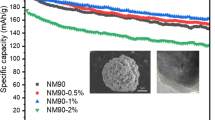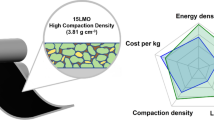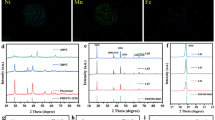Abstract
With the scarcity of cobalt resources and soaring prices, the removal of cobalt from nickel-rich layered cathodes is now a priority to reduce the material costs and develop the sustainability of lithium-ion batteries (LIBs). In this work, we report a single-crystal cobalt-free LiNi0.6Mn0.4O2 (NM64) layered oxide cathode and compare it with single-crystal LiNi0.6Co0.1Mn0.3O2 (NCM613) cathode. On the one hand, NM64 exhibits competitive energy density to NCM613 and better long-term cycle stability under a high cutoff voltage of 4.5 V. Impressively, single-crystal NM64 not only could effectively suppress the microcrack formation, resulting in the excellent structural stability and long cycling lifespan even at the full delithiated state, but also, it has superior thermal stability to single-crystal NCM613, which is beneficial to achieve high operational safety of LIBs. On the other hand, due to the removal of expensive cobalt, the material cost of NM64 is only 2/3 of NCM613, which is conducive to significantly reducing the cost of LIBs. As a result, NM64 exhibits high energy density (765.27 Wh kg−1) and remarkable cycle stability (93.21 mA h g−1 after 200 cycles at a high charging voltage of 4.5 V). Considering the cost and electrochemical performance advantages, the NM64 cathode is highly expected to stand out in the next generation of cobalt-free LIBs.





Similar content being viewed by others
References
Global EV Outlook (2020) https://www.iea.org/reports/global-ev-outlook-2020. Accessed June 2020
Alves Dias P, Blagoeva D, Pavel C, Arvanitidis N (2018) Cobalt: demand-supply balances in the transition to electric mobility. Publications Office of the European Union: 978–92–79–94311–9. https://doi.org/10.2760/97710
Kittner N, Lill F, Kammen DM (2017) Energy storage deployment and innovation for the clean energy transition. Nat Energy 2:1–6. https://doi.org/10.1038/nenergy.2017.125
Lithium-ion battery material market 2022 – major four components. Yano Research Institute. https://www.yanoresearch.com. Accessed Sept 2022
London Metal Exchange. https://www.lme.com/. Accessed Oct 2022
Banza Lubaba Nkulu C, Casas L, Haufroid V et al (2018) Sustainability of artisanal mining of cobalt in DR Congo. Nature sustainability 1:495–504. https://doi.org/10.1038/s41893-018-0139-4
Wang X, Ding YL, Deng YP, Chen Z (2020) Ni-rich/Co-poor layered cathode for automotive Li-Ion batteries: promises and challenges. Adv Energy Mater 10:1903864. https://doi.org/10.1002/aenm.201903864
Li H, Cormier M, Zhang N, Inglis J, Li J, Dahn JR (2019) Is cobalt needed in Ni-rich positive electrode materials for lithium ion batteries? J Electrochem Soc 166:A429. https://doi.org/10.1149/2.1381902jes
Olivetti EA, Ceder G, Gaustad GG, Fu X (2017) lithium-ion battery supply chain considerations: analysis of potential bottlenecks in critical metals. Joule 1:229–243. https://doi.org/10.1016/j.joule.2017.08.019
Liu TC, Yu L, Liu JJ et al (2021) Understanding Co roles towards developing Co-free Ni-rich cathodes for rechargeable batteries. Nat Energy 6:277–286. https://doi.org/10.1038/s41560-021-00776-y
Li W, Cho YG, Yao W et al (2020) Enabling high areal capacity for Co-free high voltage spinel materials in next-generation Li-Ion batteries. J Power Sources 473:228579. https://doi.org/10.1016/j.jpowsour.2020.228579
Hu EY, Yu XQ, Lin RQ et al (2018) Evolution of redox couples in Li- and Mn-rich cathode materials and mitigation of voltage fade by reducing oxygen release. Nat Energy 3:690–698. https://doi.org/10.1038/s41560-018-0207-z
Liu TC, Dai A, Lu J et al (2019) Correlation between manganese dissolution and dynamic phase stability in spinel-based lithium-ion battery. Nat Commun 10. https://doi.org/10.1038/s41467-019-12626-3
Rossen E, Jones CDW, Dahn JR (1992) Structure and electrochemistry of LiXMnYNi1-YO2. Solid State Ionics 57:311–318. https://doi.org/10.1016/0167-2738(92)90164-K
Li J, Cameron AR, Li HY et al (2017) Comparison of single crystal and polycrystalline LiNi0.5Mn0.3Co0.2O2 positive electrode materials for high voltage Li-Ion cells. J Electrochem Soc 164:A1534–A1544. https://doi.org/10.1149/2.0991707jes
Li J, Li HY, Stone W, Weber R, Hy S, Dahn JR (2017) Synthesis of single crystal LiNi0.5Mn0.3Co0.2O2 for lithium ion batteries. J Electrochem Soc 164:A3529–A3537. https://doi.org/10.1149/2.0401714jes
Wang L, Wu BR, Mu DB et al (2016) Single-crystal LiNi0.6Co0.2Mn0.2O2 as high performance cathode materials for Li-Ion batteries. J Alloy Compd 674:360–367. https://doi.org/10.1016/j.jallcom.2016.03.061
Qian GN, Zhang YT, Li LS et al (2020) Single-crystal nickel-rich layered-oxide battery cathode materials: synthesis, electrochemistry, and intra-granular fracture. Energy Storage Materials 27:140–149. https://doi.org/10.1016/j.ensm.2020.01.027
Fan XM, Hu GR, Zhang B et al (2020) Crack-free single-crystalline Ni-rich layered NCM cathode enable superior cycling performance of lithium-ion batteries. Nano Energy 70. https://doi.org/10.1016/j.nanoen.2020.104450
Sun XX, Li MC, Ren SX et al (2020) Zeolitic imidazolate framework-cellulose nanofiber hybrid membrane as Li-Ion battery separator: basic membrane property and battery performance. J Power Sources 454. https://doi.org/10.1016/j.jpowsour.2020.227878
Ryu HH, Park KJ, Yoon CS, Sun YK (2018) Capacity fading of Ni-rich Li[NixCoyMn1–x–y]O2 (0.6 ≤ x ≤ 0.95) cathodes for high-energy-density lithium-ion batteries: bulk or surface degradation? Chem Mater 30:1155–1163. https://doi.org/10.1021/acs.chemmater.7b05269
Myung ST, Maglia F, Park KJ et al (2017) Nickel-rich layered cathode materials for automotive lithium-ion batteries: achievements and perspectives. ACS Energy Lett 2:196–223. https://doi.org/10.1021/acsenergylett.6b00594
Ju SH, Kang IS, Lee YS et al (2014) Improvement of the cycling performance of LiNi0.6Co0.2Mn0.2O2 cathode active materials by a dual-conductive polymer coating. ACS Appl Mater Interfaces 6:2546–2552. https://doi.org/10.1021/am404965p
Liu Y, Harlow J, Dahn J (2020) Microstructural observations of “single crystal” positive electrode materials before and after long term cycling by cross-section scanning electron microscopy. J Electrochem Soc 167: 020512. https://doi.org/10.1149/1945-7111/ab6288
Lee JK, Oh C, Kim N, Hwang JY, Sun YK (2016) Rational design of silicon-based composites for high-energy storage devices. Journal of Materials Chemistry A 4:5366–5384. https://doi.org/10.1039/c6ta00265j
Weber R, Fell CR, Dahn JR, Hy S (2017) Operando x-ray diffraction study of polycrystalline and single-crystal LixNi0.5Mn0.3Co0.2O2. J Electrochem Soc 164: A2992. https://doi.org/10.1149/2.0441713jes
McCalla E, Carey GH, Dahn JR (2012) Lithium loss mechanisms during synthesis of layered LixNi2−xO2 for lithium ion batteries. Solid State Ionics 219:11–19. https://doi.org/10.1016/j.ssi.2012.05.007
Marks T, Trussler S, Smith AJ, Xiong D, Dahn JR (2011) A guide to Li-Ion coin-cell electrode making for academic researchers. J Electrochem Soc 158:A51. https://doi.org/10.1149/1.3515072
Wang Y, Wang E, Zhang X, Yu H (2021) High-voltage “single-crystal” cathode materials for lithium-ion batteries. Energy Fuels 35:1918–1932. https://doi.org/10.1021/acs.energyfuels.0c03608
Liang Y, Zhao CZ, Yuan H et al (2019) A review of rechargeable batteries for portable electronic devices. InfoMat 1:6–32. https://doi.org/10.1002/inf2.12000
Shumei D, Dan T, Ping L, Huiqin L, Fenyan W, Zhang H (2022) Research progress and prospect in element doping of lithium-rich layered oxides as cathode materials for lithium-ion batteries. J Solid State Electrochem. https://doi.org/10.1007/s10008-022-05294-9
Zhao Y, Gao D, Ni J, Gao L, Yang J, Li Y (2014) One-pot facile fabrication of carbon-coated Bi2S3 nanomeshes with efficient Li-storage capability. Nano Res 7:765–773. https://doi.org/10.1007/s12274-014-0437-8
Wang J, Wang Z, Ni J, Li L (2022) Electrospun materials for batteries moving beyond lithium-ion technologies. Electrochemical Energy Reviews 5:211–241. https://doi.org/10.1007/s41918-021-00103-9
Xia Y, Chen AQ, Wang K et al (2022) Industrial modification comparison of Ni-rich cathode materials towards enhanced surface chemical stability against ambient air for advanced lithium-ion batteries. J Chem Eng 450. https://doi.org/10.1016/j.cej.2022.138382
Xia Y, Ren XH, Xiao Z et al (2022) Spinel LiNi0.5Mn1.5O4 shell enables Ni-rich layered oxide cathode with improved cycling stability and rate capability for high-energy lithium-ion batteries. Electrochimica Acta 418. https://doi.org/10.1016/j.electacta.2022.140352
Wang K, Wang YF, Wang JH et al (2021) Milling time-dependent lithium/sodium storage performance of carbons synthesized by a mechanochemical reaction. Energy Fuels 35:4596–4603. https://doi.org/10.1021/acs.energyfuels.1c00089
Xia Y, Li JJ, Wang HJ et al (2019) Synthesis and electrochemical performance of poly(vinylidene fluoride)/SiO2 hybrid membrane for lithium-ion batteries. J Solid State Electrochem 23:519–527. https://doi.org/10.1007/s10008-018-4161-2
Gent WE, Busse GM, House KZ (2022) The predicted persistence of cobalt in lithium-ion batteries. Nat Energy 7:1132–1143. https://doi.org/10.1038/s41560-022-01129-z
Chu BB, Guo YJ, Shi JL et al (2022) Cobalt in high-energy-density layered cathode materials for lithium ion batteries. J Power Sources 544: 231873. https://doi.org/10.1016/j.jpowsour.2022.231873
Zhao JQ, Zhang W, Huq A et al (2017) In situ probing and synthetic control of cationic ordering in Ni-rich layered oxide cathodes. Adv Energy Mater 7:1601266. https://doi.org/10.1002/aenm.201601266
Li HY, Zhang N, Li J, Dahn JR (2018) Updating the structure and electrochemistry of LixNiO2 for 0 <= x <= 1. J Electrochem Soc 165:A2985–A2993. https://doi.org/10.1149/2.0381813jes
Kobayashi Y, Tabuchi M, Miyashiro H, Kuriyama N (2017) A new design of highly reversible LiNiO2: defect formation in transition metal site. J Power Sources 364:156–162. https://doi.org/10.1016/j.jpowsour.2017.08.027
Tang LB, Zhang B, An CS et al (2019) Ultrahigh-rate behavior anode materials of MoSe2 nanosheets anchored on dual-heteroatoms functionalized graphene for sodium-ion batteries. Inorg Chem 58:8169–8178. https://doi.org/10.1021/acs.inorgchem.9b00971
Mu LQ, Yang ZZ, Tao L et al (2020) The sensitive surface chemistry of Co-free, Ni-rich layered oxides: identifying experimental conditions that influence characterization results. J Mater Chem A 8:17487–17497. https://doi.org/10.1039/d0ta06375d
Gan Q, Qin N, Zhu Y et al (2019) Polyvinylpyrrolidone-induced uniform surface-conductive polymer coating endows Ni-rich LiNi0.8Co0.1Mn0.1O2 with enhanced cyclability for lithium-ion batteries. ACS Appl Mater Interfaces 11:12594–12604. https://doi.org/10.1021/acsami.9b04050
Ran Q, Zhao H, Hu Y et al (2018) Enhanced electrochemical performance of dual-conductive layers coated Ni-rich LiNi0.6Co0.2Mn0.2O2 cathode for Li-ion batteries at high cut-off voltage. Electrochim Acta 289:82–93. https://doi.org/10.1016/j.electacta.2018.08.091
Liu YN, Xiao Z, Zhang WK et al (2022) Poly(m-phenylene isophthalamide)-reinforced polyethylene oxide composite electrolyte with high mechanical strength and thermostability for all-solid-state lithium metal batteries. Rare Met 41:3762–3773. https://doi.org/10.1007/s12598-022-02065-3
Wang K, Lu CW, Ren Q et al (2023) Three-dimensional laminated carbon-sulfur composite cathodes derived from Trichoderma spores for lithium-sulfur batteries. J Electroanal Chem 928: 117017. https://doi.org/10.1016/j.jelechem.2022.117017
Liu Y, Tang LB, Wei HX et al (2019) Enhancement on structural stability of Ni-rich cathode materials by in-situ fabricating dual-modified layer for lithium-ion batteries. Nano Energy 65: 104043. https://doi.org/10.1016/j.nanoen.2019.104043
Choi W, Shin HC, Kim JM, Choi JY, Yoon WS (2020) Modeling and applications of electrochemical impedance spectroscopy (EIS) for lithium-ion batteries. J Electrochem Sci Technol 11: 1–13. https://doi.org/10.33961/jecst.2019.00528
Funding
This work is financially supported by the National Natural Science Foundation of China (22279116, U20A20253, 52073252 and 21972127), the Zhejiang Provincial Natural Science Foundation of China (LY21E020005, LD22E020006, 2022C01173, 2023C01231, LR20E020001 and LR20E020002), the China Postdoctoral Science Foundation (2020M671785 and 2020T130597), and the Scientific Research Project of Shaoxing City (2022003015).
Author information
Authors and Affiliations
Contributions
Yang Xia: conceptualization, funding acquisition and writing—original draft. Lexin Zhou: methodology, investigation, data curation and writing—original draft. Kun Wang: investigation and writing—original draft. Chengwei Lu: investigation and writing—original draft. Zhen Xiao: investigation, funding acquisition and writing—review and editing. Qinzhong Mao: methodology, data curation and funding acquisition. Xiaoxiao Lu: investigation and writing—original draft. Jun Zhang: investigation and visualization. Hui Huang: investigation and formal analysis. Yongping Gan: formal analysis and visualization. Xinping He: methodology and data curation. Wenkui Zhang: funding acquisition, writing—review and editing. Xinhui Xia: supervision, funding acquisition, writing—review and editing.
Corresponding authors
Ethics declarations
Competing interests
The authors declare no competing interests.
Additional information
Publisher's Note
Springer Nature remains neutral with regard to jurisdictional claims in published maps and institutional affiliations.
Yang Xia and Lexin Zhou contributed equally to this work.
Supplementary Information
Below is the link to the electronic supplementary material.
Rights and permissions
Springer Nature or its licensor (e.g. a society or other partner) holds exclusive rights to this article under a publishing agreement with the author(s) or other rightsholder(s); author self-archiving of the accepted manuscript version of this article is solely governed by the terms of such publishing agreement and applicable law.
About this article
Cite this article
Xia, Y., Zhou, L., Wang, K. et al. Economical cobalt-free single-crystal LiNi0.6Mn0.4O2 cathodes for high-performance lithium-ion batteries. J Solid State Electrochem 27, 1363–1372 (2023). https://doi.org/10.1007/s10008-023-05396-y
Received:
Revised:
Accepted:
Published:
Issue Date:
DOI: https://doi.org/10.1007/s10008-023-05396-y




